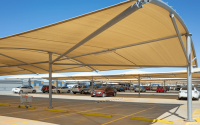Stacker Trailers: Revolutionizing Transportation in the Motorsports and Automotive Industry
In the fast-paced world of motorsports and the automotive industry, transporting high-performance vehicles safely and efficiently is crucial. Stacker trailers have emerged as an indispensable solution for hauling race cars, motorcycles, and other specialized vehicles. In this comprehensive article, we will explore the features, benefits, and considerations involved in choosing and maintaining a stacker car trailer, as well as their significance in the motorsports and automotive industry.
In the most basic form, stacker trailers are two-leveled platforms that allow for the loading and unloading of vehicles from both levels. They come in a variety of sizes and configurations to accommodate different types of vehicles, including cars, trucks, motorcycles, and ATVs. These trailers feature hydraulic lift systems with built-in ramps that offer quick and convenient access to the loading and unloading areas. Additionally, they are equipped with secure tie-down points to ensure that vehicles remain safe during transport.
The Significance of Stacker Trailers in Hauling Vehicles
Stacker trailers are designed to accommodate multiple vehicles on separate levels, maximizing storage capacity and ensuring safe transportation. These trailers are particularly useful for motorsports teams, automotive enthusiasts, and vehicle collectors who need to transport their valuable assets to various events or locations.
A lot of businesses also use stacker trailers for hauling large fleets of vehicles. The dual-level design allows them to fit twice the number of cars on one trailer, reducing transportation costs and overall fuel consumption. In addition to their practical applications, stacker trailers have come to represent a symbol of success in the motorsports and automotive industry. As such, they have become increasingly popular among vehicle enthusiasts.
Features and Benefits of Stacker Trailers
Not just any trailer can accommodate a wide range of vehicles. Stacker trailers have several features that make them ideal for transporting and hauling specialty vehicles, including:
- Durable construction: Stacker trailers are built with robust materials to ensure they can withstand the demands of long-distance transportation. They also feature an enclosed design that prevents dust from getting inside and damaging vehicles.
- Enhanced safety: Stacker trailers have secure tie-down points to ensure that vehicles remain safe during transport, as well as hydraulic lift systems with built-in ramps for easy loading and unloading.
- Cost-effectiveness: The dual-level design of stacker trailers allows businesses to fit twice the number of cars on one trailer, saving them money in fuel costs and overall transportation expenses.
- Exceptional Storage Capacity: By utilizing vertical space, stacker trailers can accommodate multiple vehicles, spare parts, tools, and equipment, making them perfect for professional motorsports teams and collectors.
- Luxurious Amenities: Many stacker trailers come equipped with comfortable living quarters, including sleeping areas, bathrooms, and kitchens, providing convenience and comfort during long journeys.
- Customization Options: Stacker trailers can be tailored to suit specific needs, whether it’s modifying the interior layout or adding specialized storage solutions for tools and spare parts.
- Ease of Loading and Unloading: Stacker trailers typically feature hydraulic lifts or ramps, making it easy to load and unload vehicles safely and efficiently.
Choosing the Right Stacker Trailer for Your Needs
There are several factors to consider when selecting a stacker trailer, including size, capacity, and features. It’s important to take into account how many vehicles you will be hauling and their weight, as well as the amount of storage space you need for tools, spare parts, and other equipment. Additionally, it’s essential to look for trailers that are constructed of strong, durable materials and equipped with secure tie-down points for extra safety.
Here are some other tips to consider when selecting a stacker trailer:
- Vehicle Types and Sizes: Choose a trailer that can accommodate the types and sizes of vehicles you need to transport, whether it’s race cars, motorcycles, or ATVs.
- Weight Capacity: Ensure the trailer has a sufficient weight capacity to safely transport your vehicles and equipment.
- Towing Vehicle Compatibility: Check that your towing vehicle is compatible with the stacker trailer and can handle the combined weight of the trailer and its contents.
- Budget: Stacker trailers can vary significantly in price, so determine your budget and prioritize the features that are most important to you.
Types of Stacker Trailers
Like any other trailer, stacker trailers come in a variety of sizes and configurations to suit different types of needs. Here are the most common types of stacker trailers:
- Open Stacker Trailers: These trailers have an open design, providing easy access to vehicles but offering less protection from the elements.
- Enclosed Stacker Trailers: Offering greater protection from weather and theft, enclosed stacker trailers are ideal for transporting high-value vehicles.
- Gooseneck Stacker Trailers: These trailers feature a gooseneck hitch, allowing for increased maneuverability and weight distribution.
Maintenance, Customization, and Buying Considerations
To ensure the longevity and optimal performance of your stacker trailer, regular maintenance is crucial. Inspect and service components such as brakes, tires, and hydraulics regularly. When customizing your trailer, work with experienced professionals who understand the unique requirements of transporting motorsports and automotive vehicles.
When buying or renting a stacker trailer, consider factors such as warranty coverage, financing options, and the reputation of the manufacturer or dealer. Research and compare different models to find the best fit for your needs. Here are some of the tips on how to maintain your stacker trailer:
- Inspect the trailer before and after each use for any wear or damage.
- Check wheel lug nuts, tire pressure, and brake lights before each trip.
- Clean the interior of the trailer regularly to prevent dirt build-up.
- Check for rust spots on the frame and replace components as needed.
- Follow manufacturer instructions for safe and proper loading of vehicles.
- Check for loose bolts, nuts, or screws on the trailer frame.
- Regularly lubricate moving parts such as the hydraulic lift system.
Stacker trailers are an invaluable resource for businesses and enthusiasts alike who need to transport their valuable assets to various events or locations. Whether you’re a professional race team or a collector of vintage cars, these versatile trailers can provide the perfect solution for secure and efficient transport.
In Conclusion
Stacker trailers have revolutionized the transportation of vehicles in the motorsports and automotive industry, offering exceptional storage capacity, luxurious amenities, and customization options. As technology advances, we can expect further innovations in stacker trailer design, making them an even more indispensable tool for transporting race cars, motorcycles, and other specialized vehicles. By understanding the features, benefits, and considerations involved in choosing and maintaining a stacker trailer, motorsports teams, and automotive enthusiasts can ensure the safe and efficient transportation of their prized vehicles.


